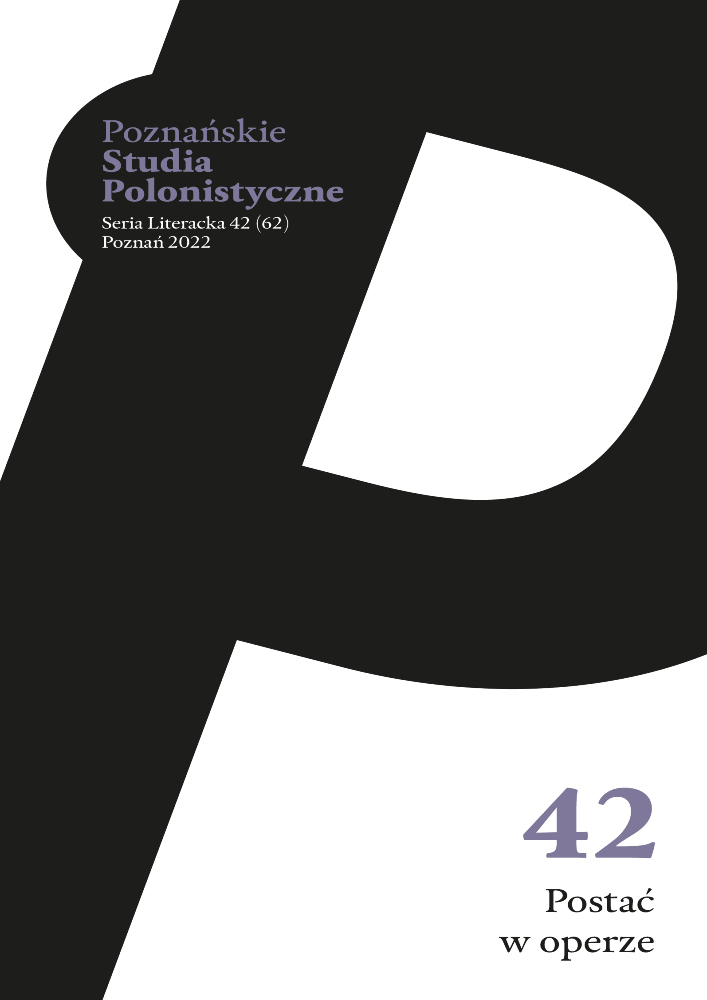Abstract
This study presents the historical range of topics related to the typology of singing voices and how they are linked to the character constituting the building material of an operatic character. This six-part overview presents the subsequent stages of the formation of the status and role of particular voices in the theory and practice of musical performance, with particular emphasis on specific vocal phenomena key to the development of operatic and solo singing: the so-called covering, haute-contre, bass-baritone and boy soprano. The reason behind the diachronic presentation of the vocal terms is to order and systematise the transformations that vocal practice, musical nomenclature and musical performance have undergone over the centuries.
References
Anonim (1765), Voix [hasło], w: Encyclopédie de Diderot et d’Alembert, vol. 17, s. 428a–432a, Paris, [dostęp: 16 czerwca 2022], https://tinyurl.com/5b2c95dh.
Berlioz Hector (1872), A travers chants: études musicales, adorations, boutades et critiques, Calmann Lévy, Paris.
Campana Alessandra (1991), Mozart’s Italian Buffo Singers, „Early Music”, vol. 19, nr 4, s. 580–583, [dostęp: 7 czerwca 2022], https://www.jstor.org/stable/pdf/3127919.pdf.
Cannon Robert (2012), Appendix 2 – The Development of Singing Voice in Opera, w: Robert Canon, Opera, Cambridge University Press, Cambridge, s. 389–393, https://doi.org/10.1017/CBO9780511980558.024.
Carducci Edgardo (1930), The Tenor Voice in Europe, „Music and Letters”, vol. 11, nr 4, s. 318–324, https://doi.org/10.1093/ml/XI.4.318.
Cyr Mary (1977), On Performing 18th-Century Haute-Contre Roles, „The Musical Times”, vol. 118, nr 1610, s. 291–295, https://doi.org/10.2307/958048.
Ehrmann-Herfort Sabine, Seedorf Thomas (1997), Stimmengattungen [MGG], Sachteil, t. 20, Kassel i in., Bärenreiter, szp. 1775–1811.
Emerson Isabelle (2005), Five Centuries of Women Singers, Praeger, Westport.
Fallows David i in. (2001), Tenor [GMO], https://doi.org/10.1093/gmo/9781561592630.article.27667.
Finscher Ludwig, Owens Jessie Ann J. A. (1997), Singen [MGG], t. 20, szp. 1412–1470.
Flotzinger Rudolf, Sanders Ernest H., Lefferts Peter M. (2001), Discant [GMO], https://doi.org/10.1093/gmo/9781561592630.article.07839.
Framery Nicolas Etienne (1818), Encyclopedie méthodique…, t. 2: Musique, Panckoucke, Paris.
García Manuel (1924), Treatise on the Art of Singing, red. Albert García, Leonard & CO, London.
Harris Ellen T. (2001), Mezzo-contralto [GMO], https://doi.org/10.1093/gmo/9781561592630.article.18569.
Hughes Andrew (1969), Some Notes on the Early Fifteenth-Century Contratenor, „Music and Letters”, vol. 50, z. 3, s. 376–387, https://doi.org/10.1093/ml/L.3.376.
Jander Owen, Harris Ellen T. (2001), Alto (i) [GMO], https://doi.org/10.1093/gmo/9781561592630.article.00693.
Jander Owen, Harris Ellen T. (2001), Bass-baritone [GMO], https://doi.org/10.1093/gmo/9781561592630.article.02234.
Jander Owen i in. (2001), Contralto [GMO], https://doi.org/10.1093/gmo/9781561592630.article.06365.
Jander Owen (2001), Contratenor altus [GMO], https://doi.org/10.1093/gmo/9781561592630.article.06372.
Jander Owen i in. (2002), Baritone [GMO], https://doi.org/10.1093/gmo/9781561592630.article.O008400.
Kloiber Rudolf, Konold Wulf, Maschka Robert (2011), Handbuch der Oper, Bärenreiter Verlag, Kassel.
Miller Richard (2000), Training Soprano Voices, Oxford University Press, Oxford.
Miller Richard (2008), Securing Baritone, Bass-Baritone, and Bass Voices, Oxford University Press, Oxford.
Pavis Patrice (2002), Słownik terminów teatralnych, przełożył, opracował i uzupełnieniami opatrzył Sławomir Świontek, Ossolineum, Wrocław.
Quantz Johann Joachim (1754), Herrn Johann Joachim Quantzens Lebenslauf, von ihm selbst entworfen, w: Wilhelm Marpurg, Historisch-Kritische Beyträge zur Aufnahme der Musik, Erstes Stück, Berlin, s. 197–250.
Reckow Fritz, Roesner Edward H. (2001), Organum, §1: Etymology, Early Usage [GMO], https://doi.org/10.1093/gmo/9781561592630.article.48902.
Riggs Geoffrey S. (2003), Assoluta Voices in Opera 1797–1847, McFarland & Company, Jefferson.
Rohringer Stefan (2012), Don Ottavio and the History of the Tenor Voice, w: Dramma Giocoso: Four Contemporary Perspectives on the Mozart/Da Ponte Operas, Leuven University Press, Leuven, s. 33–58, https://doi.org/10.2307/j.ctt9qdwt6.
Rousseau Jean Jacques (1765), Voix, w: Encyclopédie de Diderot et d’Alembert, vol. 17, s. 436a–437a, Paris, [dostęp: 19 grudnia 2021], https://tinyurl.com/4nu4s27j.
Rousseau Jean Jacques (1768), Dictionnaire de musique, Paris, [dostęp: 19 grudnia 2021], https://tinyurl.com/k78j868j.
Smith Norman E. i in. (2001), Organum [GMO], https://doi.org/10.1093/gmo/9781561592630.article.48902.
Stark James (1999), Bel Canto: A History of Vocal Pedagogy, University of Toronto Press, Toronto.
Straburzyński Michał (2007), Głos bas-barytonowy jako odrębny rodzaj głosu ludzkiego, [praca dyplomowa], Akademia Muzyczna im. I. J. Paderewskiego, Poznań.
Vest Jason Christopher (2009), Adolphe Nourrit, Gilbert-Louis Duprez, and Transformations of Tenor Technique in the Early Nineteenth Century: Historical and Physiological Considerations, Lexington, Kentucky.
Vignal Marc, red. (2005), Dictionnaire de la musique, Larousse, Paris.
Wydra Wiesław, Rzepka Ryszard, wybór i oprac. (1984), Chrestomatia staropolska. Teksty do roku 1543, Ossolineum, Wrocław.
Zaslaw Neal (1974), The Enigma of the Haute-Contre, „The Musical Times”, vol. 115, nr 1581, s. 939–941, https://doi.org/10.2307/958179.
License
Authors
Authors of texts accepted for publication in „Poznańskie Studia Polonistyczne. Seria Literacka” are required to complete, sign and return to the editor's office the Agreement for granting a royalty-free license to works with a commitment to grant a CC sub-license.
Under the agreement, the authors of texts published in „Poznańskie Studia Polonistyczne. Seria Literacka” grant the Adam Mickiewicz University in Poznań a non-exclusive, royalty-free license and authorize the use of Attribution-NoDerivatives 4.0 International (CC BY-ND 4.0)Creative Commons sub-license.
The authors retain the right to continue the free disposal of the work.
Users
Interested Internet users are entitled to use works published in „Poznańskie Studia Polonistyczne. Seria Literacka” since 2016, for non-commercial purposes only, under the following conditions:
- attribution - obligation to provide, together with the distributed work, information about the authorship, title, source (link to the original work, DOI) and the license itself.
- no derivatives - the work must be preserved in its original form, without the author's consent it is not possible to distribute the modified work, such as translations, publications, etc.
Copyrights are reserved for all texts published before 2016.
Miscellaneous
Adam Mickiewicz University in Poznań retains the right to magazines as a whole (layout, graphic form, title, cover design, logo etc.).

